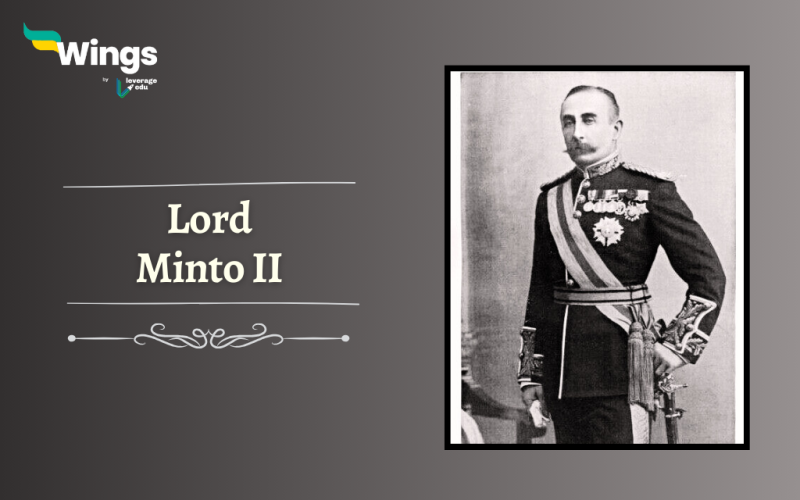Gilbert John Elliot-Murray-Kynynmound was the 4th Earl of Minto and is also known as Lord Minto II. He was a Scottish politician and was the Viceroy of India from 1905 to 1910. Interestingly, Lord Minto 1 was his great-grandfather who served as the Governor-General of India from 1807 till 1813. Lord Minto II succeeded Lord Curzon in November 1905 and Lord Hardinge was his successor in 1910. Additionally, during Lord Minto II’s time, there was the popularisation of anti-partition and Swadeshi movements, the establishment of the Muslim League and the split in Congress in Surat.
Table of Contents
What were the Events During Lord Minto II as Viceroy of India?
During Lord Minto II’s succession in 1905, there was a peak of protests against the Bengal Partition. The unrest endured despite numerous restrictive measures. Furthermore, alongside intense criticism in newspapers and public speeches, there was also hidden revolutionary activity. Additionally, a fresh wave of patriots, predominantly young and educated, who embraced the use of force and were determined to champion independence, stood against Lord Minto II. The Congress, advocating for widespread involvement in governance, also expressed opposition to Minto.
Popularisation of the Anti-Partition and Swadeshi Movements
After Lord Curzon declared the Partition of Bengal in 1905, there was immense unrest and unsettlement in Bengal. This led to the end of Lord Curzon’s term and he was succeeded by Lord Minto II. Moreover, the people did not want the partition of Bengal. That is when the Swadeshi Movement began in 1906.
Establishment of the Muslim League in 1906
When Bengal was partitioned by the British to create a distinct administrative region for Muslims, an initiative was undertaken to establish Muslims as separate political entities, hence leading to the formation of the Muslim League. Additionally, the original purpose of the Muslim League was to serve as both a political and cultural organization, although some Muslims initially harboured doubts about this concept. Aga Khan became the first President of the Muslim League.
Also Read: What was the Lucknow Pact?
The Surat Split in 1907
Lord Minto II held the position of Viceroy during the Congress Split in Surat, while Dr. Rash Bihari Ghosh presided over the Indian National Congress Session. The extremists aimed to unify various associations under the Boycott and Swadeshi Movements, thus extending their influence beyond Bengal. Conversely, the Moderates opposed broadening the movement outside Bengal and boycotting councils and similar institutions. This led to a growing division between the Moderates and the Extremists. Consequently, due to these disagreements, the Moderates opted for a split, and the Congress followed suit in Surat in December 1907.
Alipore Bomb Case of 1908
Khudiram Bose and Prafulla Chaki orchestrated a bomb explosion in April 1908 to assassinate D.H. Kingsford, the Chief Presidency Magistrate of Muzaffarpur. Unfortunately, two British women lost their lives in the incident, though the magistrate managed to survive. Moreover, Prafulla Chaki took his own life when surrounded by the police, while Khudiram Bose was apprehended by law enforcement. On the 6th of May 1909, the Indian nationalist Sri Aurobindo was acquitted.
Also Read: Champaran Satyagraha
Morley Minto Reforms of 1909
The 1909 Indian Council Act, commonly referred to as the Morley-Minto Reforms, introduced distinct electorates based on religion. This measure aimed at pleasing the moderates within the Congress which led to Lord Minto being recognized as the “Father of the Communal Electorate” in India. The reforms resulted in the addition of extra members to the national and provincial legislative councils. However, it’s noteworthy that only a minority of council members were elected officials.
Nasik Conspiracy Case in 1909
VD Savarkar established the Abhinav Bharat Society in 1904. In 1909, A.M.T. Jackson, the district magistrate of Nasik, was assassinated by Anant Lakshaman Karkare, a member of this society. Furthermore, Jackson known for his popularity and expertise in Indian culture, became the victim of this tragic incident. Subsequently, 27 members of the Abhinav Bharat Society were convicted and faced legal consequences for their involvement in the assassination. As part of the repercussions, VD Savarkar’s brother, Ganesh, was sentenced to imprisonment in Andaman, known for its notorious Kala Pani penal settlement.
Also Read: Indian Freedom Fighters
The Legacy of Lord Minto II
Lastly, Lord Minto observed and engaged in numerous events that would permanently alter the trajectory of the subcontinent throughout his five-year tenure as the Viceroy of India. Moreover, the introduction of separate electorates shifted the dynamics in the struggle for Indian independence, despite its initial appearance as a symbolic act.
The groundwork was already laid for events that would ultimately culminate in one of the century’s most significant divisions, the Partition of India, although subsequent developments would ultimately shape the future of the subcontinent.
FAQs
Lord Minto II was a Scottish politician and the Viceroy of India from 1905 to 1910. Lord Minto 1, the First Earl of Minto, was his great-grandfather who served as the Governor-General of India from 1807 till 1813.
Lord Minto was the Viceroy of India from 1905 to 1910. Lord Minto II succeeded Lord Curzon in November 1905 and Lord Hardinge was his successor in 1910.
Lord Minto’s full name is Gilbert John Elliot-Murray-Kynynmound, he was also the Fourth Earl of Minto.
Lord Minto is also known as the “Father of the Communal Electorate” in India.
Other Viceroys of India
We hope you liked our blog on Lord Minto II. If you want to read more articles like this, you can read Study Notes on the Modern History of India. Also, you can visit our general knowledge page on Indian History!
 One app for all your study abroad needs
One app for all your study abroad needs













